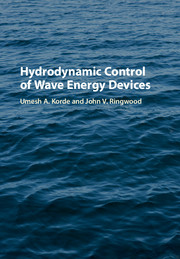Book contents
- Frontmatter
- Contents
- Preface
- Acknowledgments
- Part I Introduction
- Part II The Basics
- Part III The Hydrodynamics
- Part IV Velocity Control Using a Hydrodynamic Model
- 7 Reactive Control in Time Domain
- 8 A Causal Real-Time Controller for Wave Energy Converters
- Part V Control by Optimizing a Performance Index
- Part VI Toward Overall WEC System Hydrodynamic Optimization
- Part VII In Closing
- References
- Index
7 - Reactive Control in Time Domain
from Part IV - Velocity Control Using a Hydrodynamic Model
Published online by Cambridge University Press: 05 September 2016
- Frontmatter
- Contents
- Preface
- Acknowledgments
- Part I Introduction
- Part II The Basics
- Part III The Hydrodynamics
- Part IV Velocity Control Using a Hydrodynamic Model
- 7 Reactive Control in Time Domain
- 8 A Causal Real-Time Controller for Wave Energy Converters
- Part V Control by Optimizing a Performance Index
- Part VI Toward Overall WEC System Hydrodynamic Optimization
- Part VII In Closing
- References
- Index
Summary
As we have seen repeatedly in the previous chapters, a differential equation description of a wave energy device holds only in regular waves, due to the nature of the radiation force. A frequency domain thought process leading to the cancellation of the reactive terms in the dynamics and matching of the radiation damping (ignoring viscosity) is accurate only on a frequency-by-frequency basis. As a real wave input at any given time in general contains the combined effect of numerous frequency components, reactive cancellation and resistive matching requires a time domain approach that works on a wave-by-wave basis. Several control approaches have emerged in recent years that are based on the integro-differential equation description (Cummins’ equation) of a device [63], seeking to optimize energy absorption based on certain performance criteria. In light of our discussion in Chapters 4 and 6, any approach leading to the hydrodynamic optimum for the real-time velocity in irregular waves must seek reactive cancellation and resistive matching in real time. The degree of approximation and realism employed in attempting to reach the hydrodynamic optimum and the amount of information required as to the incoming waves have varied over the years. The goal of this chapter is to describe the closest practical approaches to the hydrodynamic velocity optimum in the time domain.
Approaching the Hydrodynamic Optimum
Reactive control was first attempted in the mid-1970s by Salter [92] and Budal [93]. Both were able to increase the bandwidth, that is, the range of frequencies where good conversion occurred. Salter first implemented it in the “narrow tank,” using analog instrumentation to measure the instantaneous position and velocity of the duck and using both to determine the torque that opposed the duck oscillation. The torque contained a part proportional to displacement, a part proportional to velocity, and a part proportional to acceleration. The adjustable constants of proportionality constituted, respectively, the load spring, load damping, and load inertia. Negative spring and positive inertias were used to extend the bandwidth into the longer-period range. Effectively, this amounted to controlling both the amplitude and the phase of the force applied by the Power take-off (PTO).
Information
- Type
- Chapter
- Information
- Hydrodynamic Control of Wave Energy Devices , pp. 151 - 181Publisher: Cambridge University PressPrint publication year: 2016
